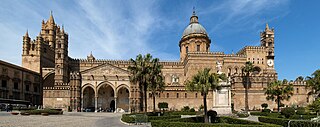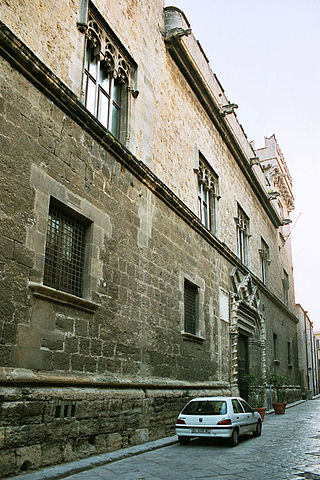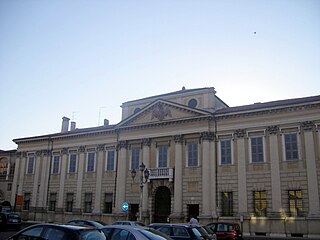
The House of Medici was an Italian banking family and political dynasty that first consolidated power in the Republic of Florence under Cosimo de' Medici, during the first half of the 15th century. The family originated in the Mugello region of Tuscany, and prospered gradually until it was able to fund the Medici Bank. This bank was the largest in Europe during the 15th century and facilitated the Medicis' rise to political power in Florence, although they officially remained citizens rather than monarchs until the 16th century.

Villa del Poggio Imperiale is a predominantly neoclassical former grand ducal villa in Arcetri, just to the south of Florence in Tuscany, Central Italy. Beginning as a villa of the Baroncelli of Florence, it was seized by the Medici, became the home of a Medici princess, and a lavish retreat for a Grand Duchess with imperial pretensions. Later given to Napoleon's sister, it was reclaimed by the hereditary rulers of Tuscany before being finally converted to a prestigious girls' school. During its long history, it has often been at the centre of Italy's turbulent history, and has been rebuilt and redesigned many times.

Sicilian Baroque is the distinctive form of Baroque architecture which evolved on the island of Sicily, off the southern coast of Italy, in the 17th and 18th centuries, when it was part of the Spanish Empire. The style is recognisable not only by its typical Baroque curves and flourishes, but also by distinctive grinning masks and putti and a particular flamboyance that has given Sicily a unique architectural identity.

Giuseppe Venanzio Marvuglia was an Italian architect.

Palermo Cathedral is the cathedral church of the Roman Catholic Archdiocese of Palermo, located in Palermo, Sicily, southern Italy. It is dedicated to the Assumption of the Virgin Mary. As an architectural complex, it is characterized by the presence of different styles, due to a long history of additions, alterations and restorations, the last of which occurred in the 18th century.

Palazzo Braschi is a large Neoclassical palace in Rome, Italy and is located between the Piazza Navona, the Campo de' Fiori, the Corso Vittorio Emanuele II and the Piazza di Pasquino. It presently houses the Museo di Roma, the "Museum of Rome", covering the history of the city in the period from the Middle Ages through the nineteenth century.

Santa Cristina is a Neoclassical-style, Roman Catholic church in Pisa, region of Tuscany, Italy. It is located on the Lungarno Gambacorti.

Palazzo Abatellis is a palazzo in Palermo, Sicily, southern Italy, located in the Kalsa quarter. It is home to the Galleria Regionale della Sicilia, the Gallery of Art for the Sicilian region.

The Royal Palace of Milan was the seat of government in the Italian city of Milan for many centuries. Today, it serves as a cultural centre and it is home to international art exhibitions. It spans through an area of 7,000 square meters and it regularly hosts modern and contemporary art works and famous collections in cooperation with notable museums and cultural institutions from across the world. More than 1,500 masterpieces are on display annually.

The Catherine Palace is a Neoclassical residence of Catherine II of Russia on the bank of the Yauza River in Lefortovo, Moscow. It should not be confused with the much more famous Catherine Palace in Tsarskoye Selo.

Piazza Pretoria is at the limits of the district of Kalsa, near the corner of Cassaro with Via Maqueda, just a few meters from the Quattro Canti, the intersection where all the four ancient quarters intersect, in the city of Palermo, region of Sicily, Italy.

Vincenzo Riolo was an Italian painter of the Neoclassical style, active mainly in his native Sicily.

The Palazzo D'Arco is a Neoclassical-style palace located on Piazza Carlo D'Arco #4 in Mantua, region of Lombardy, Italy. The palace houses the Museo di Palazzo d'Arco, which displays the furnishings and artwork collected by the Duke D'Arco.

The Church of Saint Francis of Assisi is a Gothic-style, Roman Catholic church of Palermo. It is located near a major and ancient street of the city, via Cassaro, in the quarter of the Kalsa, within the historic centre of Palermo. The building represents the main Conventual Franciscan church of Sicily, and has the title of minor basilica.

The Biondo Theatre is a neoclassical and Art Nouveau-style theater building located on Via Roma #258, corner with Via Venezia, in the ancient quarter of Castellamare of central Palermo, region of Sicily, Italy. Diagonally across Via Roma is the ancient church of Sant'Antonio Abate and a stairwell descending into the warrens of the Vucciria Market.

The Church of Saint Teresa is a Baroque Roman Catholic church, located on Piazza della Kalsa, facing the Porta de Greci in the ancient quarter of the Kalsa of the city of Palermo, region of Sicily, Italy.
During 1956–57 season Associazione Calcio Milan competed in Serie A and Latin Cup.

The Palazzo Jung is a Neoclassical-style palace located on Via Lincoln, in front of the Orto Botanico of Palermo, in the city of Palermo, region of Sicily, Italy.

The Palazzo Forcella de Seta is an eclectic-style aristocratic palace located facing the Mediterranean in the ancient quarter of Kalsa of central Palermo, region of Sicily, Italy. The palace was built atop the base of the former defensive walls of the city, including the Vega bastion and in its center, an original city gate, Porta dei Greci (1553) through which via Romano Giuseppe runs through. Some refer to the entire structure as the gate. To the seaside, stretches part of the park Foro Italico. In front of the Northeast corner, in front of the seaside facade, is the Monument to Vincenzo Florio Sr..
Antonio Manno was an Italian painter of the Neoclassical style, active mainly in his Sicily.



















